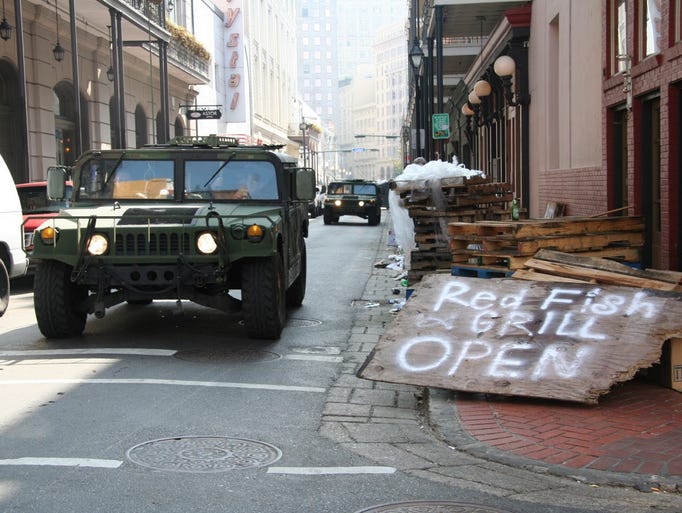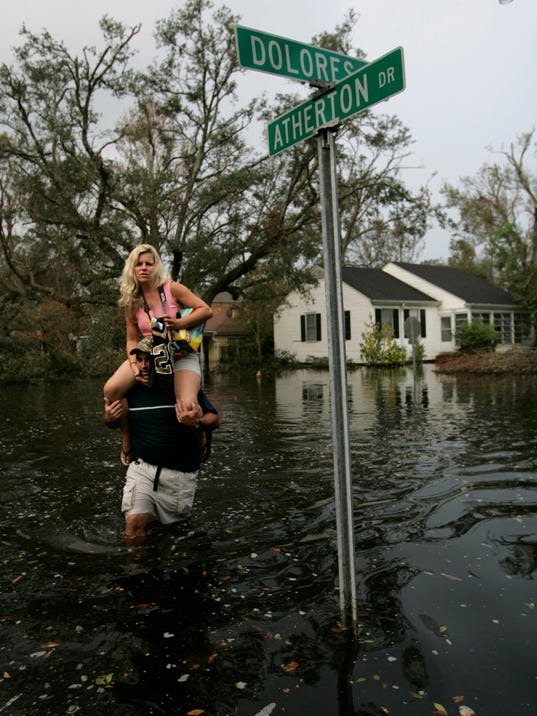Strict Standards: Only variables should be assigned by reference in /home/noahjames7/public_html/modules/mod_flexi_customcode/tmpl/default.php on line 24
Strict Standards: Non-static method modFlexiCustomCode::parsePHPviaFile() should not be called statically in /home/noahjames7/public_html/modules/mod_flexi_customcode/tmpl/default.php on line 54
Strict Standards: Only variables should be assigned by reference in /home/noahjames7/public_html/components/com_grid/GridBuilder.php on line 29
Hurricane Katrina changed the Gulf Coast landscape and face of its culture when it hit in 2005. Key events show the progression and setbacks of the damage, rescue and rebuilding.
Aug. 25, 2005
Hurricane Katrina hits the Florida coast as a Category 1 with winds at 80 mph. Florida Gov. Jeb Bush declares a State of Emergency.
Aug. 26
Louisiana Gov. Kathleen Blanco declares a State of Emergency. The White House deploys National Guard troops to the Gulf Coast.
10:30 a.m. CT — Katrina intensifies to a Category 2.
Aug. 27
5 p.m. — New Orleans Mayor Ray Nagin starts a voluntary evacuation of New Orleans metro-area residents.
Evening — Mississippi Gov. Haley Barbour declares a State of Emergency.
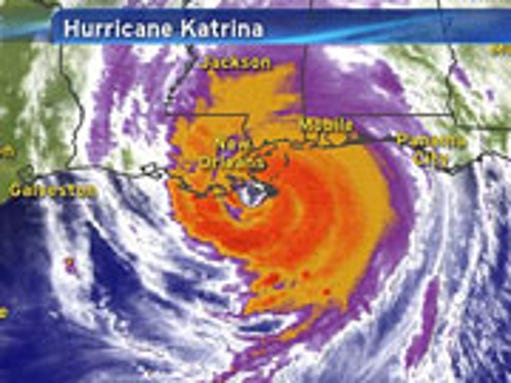
A satellite image of Hurricane Katrina at 6 a.m. ET on Aug. 28, 2005, heading toward Louisiana's coastline. (Photo: NOAA, The Weather Channel)
Aug. 28
7 a.m. — Katrina becomes a Category 5 storm with winds at about 160 mph.
9:30 a.m. — Nagin orders first ever mandatory evacuation for New Orleans residents. Shelters such as the Superdome are listed as "refuges of last resort."
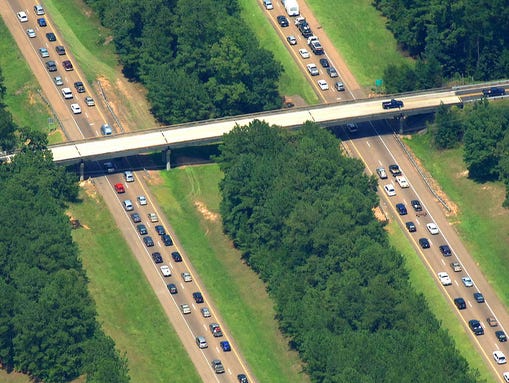
All lanes of I-55 open to northbound traffic near Brookhaven, Miss., on Aug. 28, 2005, as people evacuate ahead of Hurricane Katrina. (Photo: Chris Todd, The (Jackson, Miss.) Clarion-Ledger)
11:30 a.m. — President George W. Bush vows support to help those affected and said he signed disaster declarations for Louisiana and Mississippi.
Afternoon — National Weather Service warns a significant storm surge could send water over the top of some levees in New Orleans. Alabama Gov. Bob Riley declares a State of Emergency.
6 p.m. — Nagin orders a 6 p.m. curfew.
Late — About 25,000-30,000 New Orleans residents seek shelter in the Superdome.
Aug. 29
6:10 a.m. — Katrina makes landfall as a Category 3 on the Gulf Coast.
9 a.m. — A levee is breached in the Lower Ninth Ward, and more breaks are reported in the Industrial Canal and 17th Street Canal. Water begins pouring into eastern New Orleans, the Lower Ninth Ward and St. Bernard Parish. Thousands of people were trapped on rooftops and in attics.
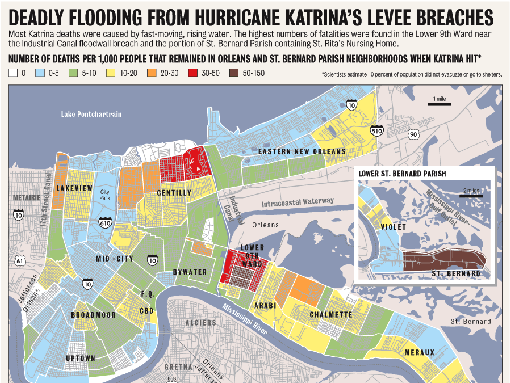
Hurricane Katrina Levee Breach graphic. (Photo: USA TODAY)
11 a.m. — Katrina's strongest winds reach 125 mph as the peak storm surge hits Biloxi and Gulfport, Miss.
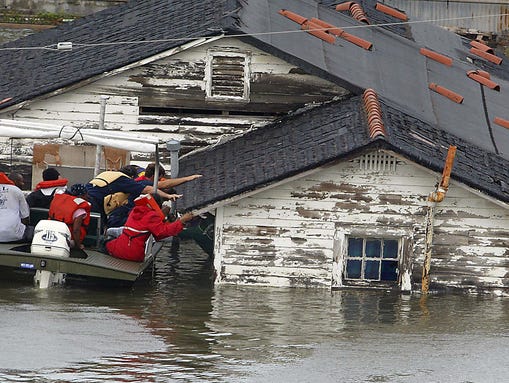
Ronald Wood is rescued from his home in New Orleans after Hurricane Katrina made landfall in August 2005. (Photo: James Nielsen, AFP/Getty Images)
Afternoon — The storm rips a hole in the Superdome, putting sheltered victims at risk. Bush declares an Emergency Disasterfor Louisiana and Mississippi.
Aug. 30
7 a.m. — Katrina is downgraded to a tropical storm while passing over Tennessee.
Morning — Katrina dissipates with winds down to 35 mph. About 80% of New Orleans is covered in water as high as 20 feet.Looting starts, and officers are redirected from rescue operations to stop violence.
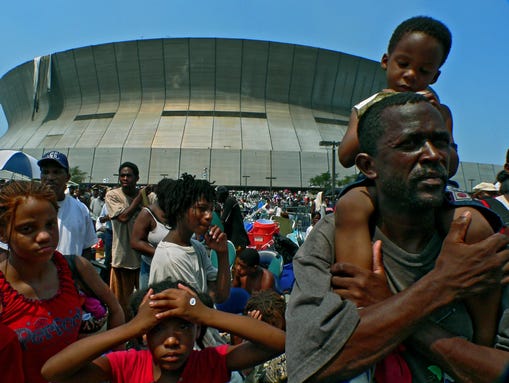
Hurricane Katrina victims wait for transportation outside the Louisiana Superdome in New Orleans on Sept. 2, 2005. (Photo: Karl Merton Ferron, AP)
Evening — Blanco orders an evacuation of the Superdome, which is surrounded by water and houses about 15,000-20,000 people.
Aug. 31
Morning — Blanco orders a total evacuation of New Orleans. Texas Gov. Rick Perry opens the Houston Astrodome for refugees coming from the Superdome. U.S. Health and Human Services Secretary Michael Leavitt declares a public health emergency in Mississippi, Alabama, Louisiana and Florida.

A man pulls people in a boat down a flooded street in New Orleans on Aug. 31, 2005, two days after Hurricane Katrina struck. (Photo: Nicole Fruge, San Antonio Express News, via AP)
Afternoon — Water levels have equalized between Lake Pontchartrain and the city. Rescuers try to reach those stranded on roofs and in hospitals, but communications are limited or out.
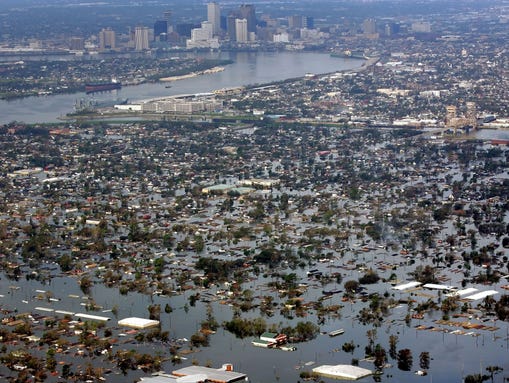
Floodwaters from Hurricane Katrina cover a portion of New Orleans on Aug. 30, 2005. (Photo: David J. Phillip, AP)
Sept. 1
Morning — Nagin sends out an SOS for more help and buses to get people stuck in the convention center out. They are running out of food and shelter. FEMA rescue operations suspend as violence and gunshots at emergency helicopters threaten workers' safety.
Evening — FEMA Director Michael Brown says he has finally learned about the evacuees stuck in the convention center, but a Frontline interview later reveals he knew about the people there Aug. 31.
Sept. 2
Congress approves a $10.5 billion aid package for rescue and relief. Bush signs the bill and tours the Gulf region. Bush concedes that the recovery is not proceeding well. "I am satisfied with the response. I am not satisfied with all the results," he says. Airlines begin shuttling people out of the region. Decomposing bodies lie unattended on the streets.
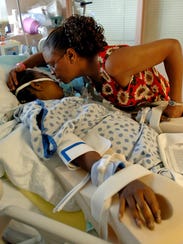
Elaine Bias kisses her daughter in the intensive care unit at Baylor Medical Center Dallas on Sept. 13, 2005. Laticia Young, who needs a liver transplant, was in Lindy Boggs Hospital in New Orleans during Hurricane Katrina. (Photo: Mark W. Williams, USA TODAY)
Sept. 3
Forty thousand personnel from the National Guard work on the Gulf Coast. The American Red Cross cares for about 96,000 people in nine different states. Many police officers have walked off the job.
Trash is piled several feet high in the Superdome.All refugees are evacuated from the site.
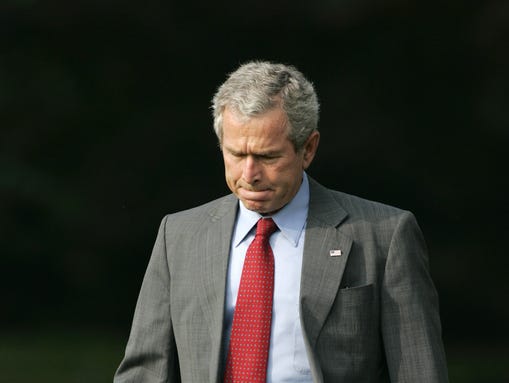
President Bush heads back to the Hurricane Katrina damage zone from Washington on Sept. 20, 2005. (Photo: J. Scott Applewhite, AP)
Sept. 4
Five New Orleans police officers shoot six unarmed residents on Danziger Bridge in the city. Two are killed.
Sept. 5
The 17th Street Canal breech is repaired. The Army Corp of Engineers starts work on the London Avenue Canal breech and begins pumping out the water. Floodwater starts to recede in New Orleans. The Ninth Ward is about a foot down. The death toll remains unofficial and estimated.
Sept. 6
Engineers estimate it could take 80 days to pump the water out. About 20,000 people have been flown out of the Louis Armstrong New Orleans International Airport since the storm.
Sept. 7-9
Bush requests an additional $51.8 billion in federal aid. Congress approves the bill. Foreign aid donors get frustrated with how their nearly $1 billion is distributed. Katrina damage estimates hit $125 billion.
Sept. 12
FEMA Director Brown resigns in response to critics saying he sent aid too late and was uncoordinated. Bush appoints his replacement, career firefighter R. David Paulison.
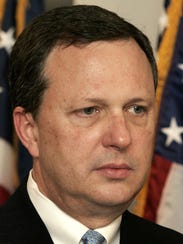
Michael Brown resigned as FEMA director in the aftermath of Hurricane Katrina on Sept. 12, 2005. (Photo: Bill Pugliano, Getty Images)
Sept. 15
Mississippi Attorney General Jim Hood sues five insurance companies to force them to pay for storm-surge damage related to Hurricane Katrina. A dispute over the cause of damage — wind-driven rain or flooding — slows or stalls the distribution of funds to victims.
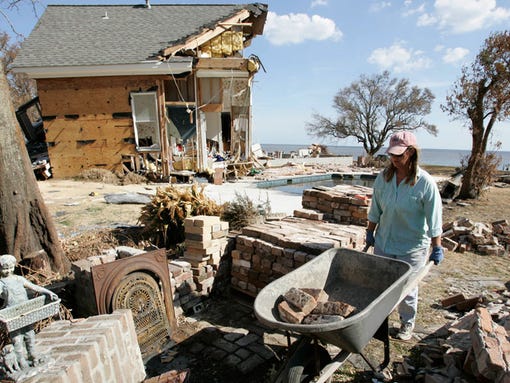
Cindy Frank cleans up debris from her father's house, which was destroyed by Hurricane Katrina in Pascagoula, Miss., on Sept. 7, 2005. (Photo: H. Darr Beiser, USA TODAY)
Sept. 22
Hurricane Rita roars toward Texas and Louisiana at Category 4 wind speeds. About 1.8 million fleeing residents clog highways, and many run out of fuel on the road.
Sept. 24
Houston is spared expected damage from Rita. The storm's impact is less than anticipated.
Sept. 28
About 1.3 million people are dispersed in all 50 states from Katrina, according to the first official accounting.
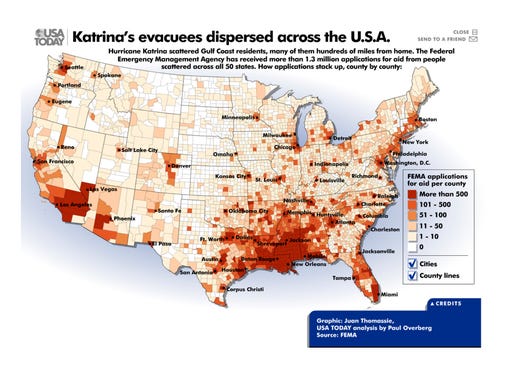
A map of the dispersed people from Hurricane Katrina on Sept. 28, 2005. (Photo: USA TODAY)
Oct. 3
Rescuers stop the search for victims and bodies in Louisiana. The death toll sits at 964.
Nov. 21
The estimated death toll rises to 1,306 people.Most of the dead were elderly. At least 1,000 of the 6,644 people unaccounted for are children.
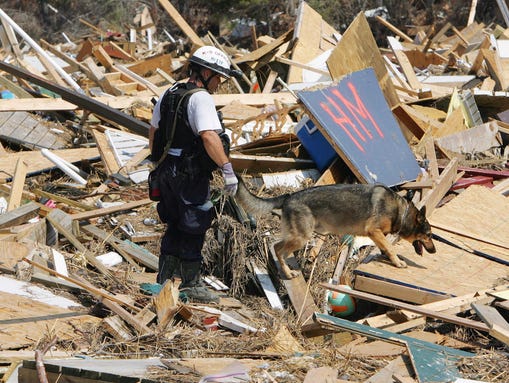
Capt. Matthew Zarrella, with his cadaver dog Maximus, search through a Hurricane Katrina-destroyed home and debris field for possible bodies outside Waveland, Miss., on Sept. 21, 2005. (Photo: Ric Feld, AP)
Dec. 17
Congress agrees to send $29 billion in additional aid for Katrina victims. The funds will go to schools, levee protection in New Orleans and homeowners who won't receive flood insurance money.
2006
Jan. 24
The White House stops its staff from answering questions or handing over documents to Senate and House investigations into the Katrina response.
2007
April 16
A federal judge awards a Louisiana man $2.8 million in a lawsuit against insurance company Allstate. This sets a new standard for others who have filed against insurance companies in the state for damage not paid for in Katrina's aftermath.
Aug. 12
About 66% of the pre-Katrina population has returned to New Orleans. Delays in federal funding keep basic services limited, including for schools, child care and city buses. The city's economy shows signs of recovery: Revenue from sales tax sits at 84% of pre-Katrina levels.
Aug. 29
Rebuilding the city's houses and infrastructure bounces between privately funded efforts by communities and slow federal aid two years after the hurricane. None of the 115 critical priorities identified by city officials has been completed — the New Orleans police superintendent and most of the city's firefighters work out of trailers.
November
The Army Corps of Engineers remains short of clay to rebuild the levees. They need 145 million cubic yards and have acquired 20 million in the two years since the storm.
2008
Feb. 14
Thousands of people living in FEMA-provided trailers are asked to evacuate because of unhealthy levels of the chemical formaldehyde in the units, according to a Centers for Disease Control and Prevention announcement. After complaints of residents waking up with nosebleeds, hacking coughs and headaches in late 2005 and early 2006, journalist and activist Becky Gillette tests 32 FEMA-issued emergency trailers for formaldehyde. She discovers 30 of the trailers registered unsafe levels and prompts the CDC and FEMA to take action.

Becky Gillette stands in a park near her home in Eureka Springs, Ark., on April 9, 2008. Gillette, who was an unpaid volunteer for the Sierra Club, was responsible for finding that the FEMA-issued trailers given to victims of Hurricane Katrina produced a harmful level of formaldehyde. (Photo: Spencer Tirey, USA TODAY)
2009
May
About 1,400 people died in Hurricane Katrina and its aftermath. Numbers aren't completely clear because of bodies left unidentified and those that are not accounted for. New studies reveal data on who died and why.
2011
Aug. 5
A federal jury convicts five current or former New Orleans police officers of civil rights violations for the shooting deaths of a teenager and a mentally disabled man as they crossed the Danziger Bridge in search of food and help. Four others were wounded.
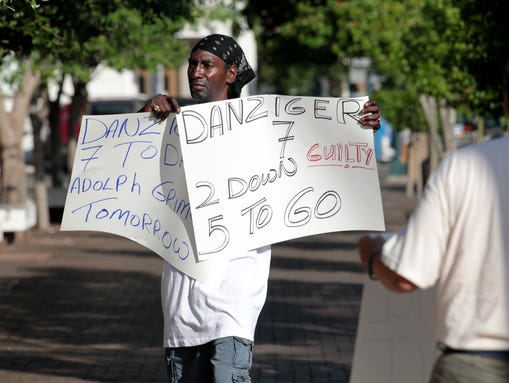
Tabari Simpson protests outside federal court in New Orleans on June 27, 2011, the opening day of the trial for five current or former New Orleans police officers charged in deadly shootings of unarmed residents on the Danziger bridge in Hurricane Katrina's chaotic aftermath. (Photo: Gerald Herbert, AP)
2012
April 4
The five former New Orleans police officers that shot six unarmed residents in the days after Katrina are sentenced. They receive a range of prison terms from six to 65 years.
2013
Aug. 29
Residents of Waveland, Miss., open a Ground Zero Hurricane Museum on the eighth anniversary of the storm. "After Katrina, we lost all of our history," Waveland Alderwoman LiLi Stahler said. "For many of our residents, the bricks and mortar of this building are all they have left of their childhood."
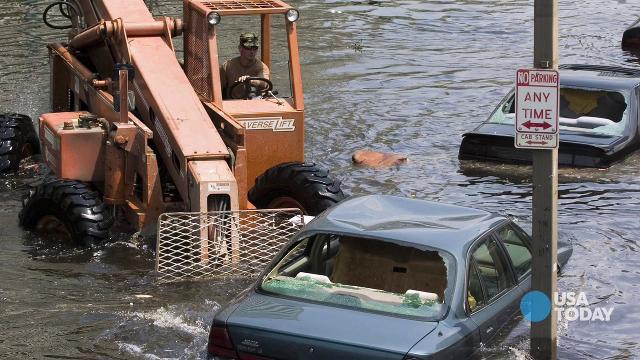
UP NEXT
03
Shannon Rae Green hosts USA NOW, covering the weather advisory sent 8 years ago to the country several hours before the devastating Category 5 hurricane hit the Gulf Coast. USA NOW, USA TODAY, Natalie DiBlasio,
More than 1,000 restaurants operate in New Orleans, up from the 800 that existed in 2005. That number grows by the month.
Dec. 28
Feb. 12
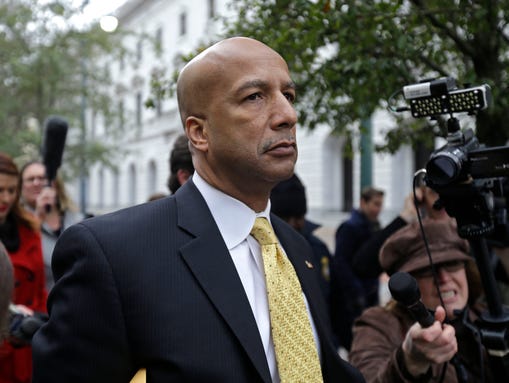
Former New Orleans mayor Ray Nagin leaves federal court Feb. 12, 2014, after his conviction in New Orleans. He was found guilty on charges that included bribery, money laundering and fraud. (Photo: Gerald Herbert, AP)

This is the sort of storm surge flooding map that would be produced if a hurricane threatened the Fort Myers, Fla., area. (Photo: National Hurricane Center)
Former New Orleans Mayor Ray Nagin was sentenced Wednesday to 10 years in prison for bribery, money laundering and other corruption that spanned his two terms as mayor, including the chaotic years after Hurricane Katrina hit in 2005. (July 9) AP
Despite the $10 billion that has gone to reconstruction from Katrina damage, $2.5 billion set aside remains untouched as projects stay open. FEMA has not set a timetable for all-project completion.
Ten years of rebuilding post-Katrina has brought change to New Orleans. Residents talk about the changes to the city ten years after the hurricane. USA TODAY
Aug. 29
The 10-year anniversary of Hurricane Katrina. The storm killed at least 1,833 people and residents are still rebuilding the ravaged cities.

